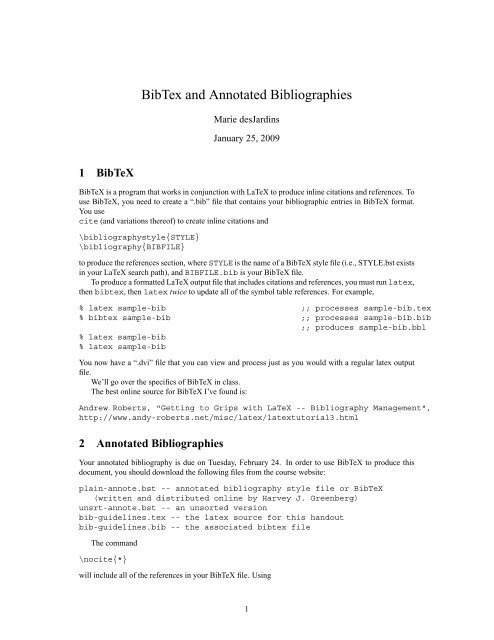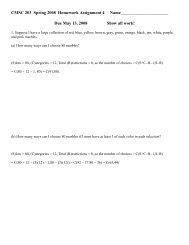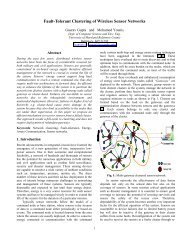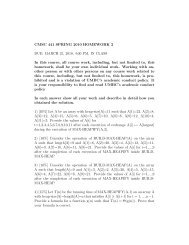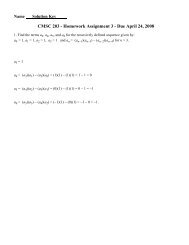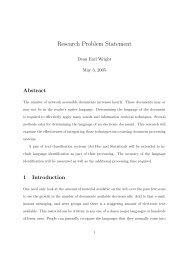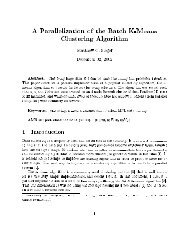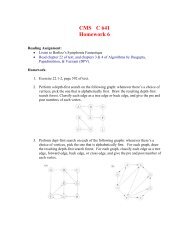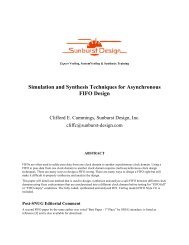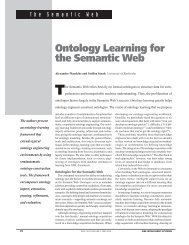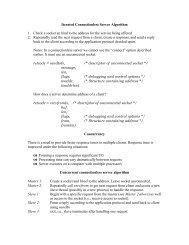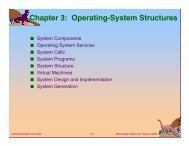BibTex and Annotated Bibliographies
BibTex and Annotated Bibliographies
BibTex and Annotated Bibliographies
You also want an ePaper? Increase the reach of your titles
YUMPU automatically turns print PDFs into web optimized ePapers that Google loves.
<strong>BibTex</strong> <strong>and</strong> <strong>Annotated</strong> <strong>Bibliographies</strong><br />
Marie desJardins<br />
January 25, 2009<br />
1 BibTeX<br />
BibTeX is a program that works in conjunction with LaTeX to produce inline citations <strong>and</strong> references. To<br />
use BibTeX, you need to create a “.bib” file that contains your bibliographic entries in BibTeX format.<br />
You use<br />
cite (<strong>and</strong> variations thereof) to create inline citations <strong>and</strong><br />
\bibliographystyle{STYLE}<br />
\bibliography{BIBFILE}<br />
to produce the references section, where STYLE is the name of a BibTeX style file (i.e., STYLE.bst exists<br />
in your LaTeX search path), <strong>and</strong> BIBFILE.bib is your BibTeX file.<br />
To produce a formatted LaTeX output file that includes citations <strong>and</strong> references, you must run latex,<br />
then bibtex, then latex twice to update all of the symbol table references. For example,<br />
% latex sample-bib ;; processes sample-bib.tex<br />
% bibtex sample-bib ;; processes sample-bib.bib<br />
;; produces sample-bib.bbl<br />
% latex sample-bib<br />
% latex sample-bib<br />
You now have a “.dvi” file that you can view <strong>and</strong> process just as you would with a regular latex output<br />
file.<br />
We’ll go over the specifics of BibTeX in class.<br />
The best online source for BibTeX I’ve found is:<br />
Andrew Roberts, "Getting to Grips with LaTeX -- Bibliography Management",<br />
http://www.<strong>and</strong>y-roberts.net/misc/latex/latextutorial3.html<br />
2 <strong>Annotated</strong> <strong>Bibliographies</strong><br />
Your annotated bibliography is due on Tuesday, February 24. In order to use BibTeX to produce this<br />
document, you should download the following files from the course website:<br />
plain-annote.bst -- annotated bibliography style file or BibTeX<br />
(written <strong>and</strong> distributed online by Harvey J. Greenberg)<br />
unsrt-annote.bst -- an unsorted version<br />
bib-guidelines.tex -- the latex source for this h<strong>and</strong>out<br />
bib-guidelines.bib -- the associated bibtex file<br />
The comm<strong>and</strong><br />
\nocite{*}<br />
will include all of the references in your BibTeX file. Using<br />
1
\bibliographystyle{plain-annote}<br />
\bibliography{BIBFILE}<br />
will produce a references section in annotated-bibliography format, using the annote field in the Bib-<br />
TeX entries for the annotations. (The references section in this h<strong>and</strong>out were produced in this way.)<br />
I haven’t been able to find a BibTeX style file that will let you group references together <strong>and</strong> include<br />
section headers (as in Zobel’s annotated bibliography on pp. 164–170). To get the section headers that<br />
you see in the annotated bibliography here, I explicitly listed all of the papers I wanted to use, in the order<br />
I wanted them to appear.<br />
\nocite{boutilier97,boutilier01,bacchus96,cohen01}<br />
I used the unsrt-annote.bst BibTeX style file, then edited the bib-guidelines.bbl file (which Bib-<br />
TeX produces) manually, after running BibTeX. Each section header is produced by the line<br />
\subsection*{SECTION HEADER}<br />
just before the first<br />
bibitem entry for that section. This isn’t a very pretty solution, because every time you change your<br />
BibTeX database <strong>and</strong> re-run BibTeX, you have to edit the .bbl file again. But it works. (Obviously,<br />
your section headers should be more semantically meaningful than mine...)<br />
References<br />
[1] Craig Boutilier, Ronen Brafman, Chris Geib, <strong>and</strong> David Poole. A constraint-based approach to<br />
preference elicitation <strong>and</strong> decision making. In AAAI Spring Symposium on Qualitative Decision<br />
Theory, 1997.<br />
Boutilier is one of the most published researchers in the area; this seems like a nice<br />
approach to the general problem, <strong>and</strong> should have some good references to follow.<br />
[2] Craig Boutilier, Fahiem Bacchus, <strong>and</strong> Ronen I. Brafman. UCP-Networks: A directed graphical<br />
representation of conditional utilities. In Proceedings of the Conference on Uncertainty in AI, 2001.<br />
Not about preference elicitation per se, but about representing structured utilities, which<br />
can help to guide the elicitation process.<br />
[3] Fahiem Bacchus <strong>and</strong> Adam J. Grove. Utility independence in a qualitative decision theory. In<br />
Proceedings of KR’96, pages 542–552, 1996.<br />
Everybody seems to cite this paper.<br />
[4] William W. Cohen, Robert E. Schapire, <strong>and</strong> Yoram Singer. Learning to order things. Journal of AI<br />
Research, 10:243–270, 1999.<br />
Not exactly elicitation of a full preference function, but a related problem of learning<br />
rank-ordering functions over sets of objects.]<br />
2


